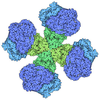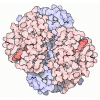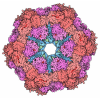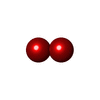[English] 日本語
 Yorodumi
Yorodumi- PDB-1j30: The crystal structure of sulerythrin, a rubrerythrin-like protein... -
+ Open data
Open data
- Basic information
Basic information
| Entry | Database: PDB / ID: 1j30 | ||||||
|---|---|---|---|---|---|---|---|
| Title | The crystal structure of sulerythrin, a rubrerythrin-like protein from a strictly aerobic and thermoacidiphilic archaeon | ||||||
 Components Components | 144aa long hypothetical rubrerythrin | ||||||
 Keywords Keywords | ELECTRON TRANSPORT / rubrerythrin / sulerythrin / Sulfolobus tokodaii strain 7 / four-helix bundle / domain swapping / metal binding site plasticity / STRUCTURAL GENOMICS | ||||||
| Function / homology |  Function and homology information Function and homology information | ||||||
| Biological species |   Sulfolobus tokodaii (archaea) Sulfolobus tokodaii (archaea) | ||||||
| Method |  X-RAY DIFFRACTION / X-RAY DIFFRACTION /  SYNCHROTRON / SYNCHROTRON /  MOLECULAR REPLACEMENT / Resolution: 1.7 Å MOLECULAR REPLACEMENT / Resolution: 1.7 Å | ||||||
 Authors Authors | Fushinobu, S. / Shoun, H. / Wakagi, T. | ||||||
 Citation Citation |  Journal: Biochemistry / Year: 2003 Journal: Biochemistry / Year: 2003Title: The Crystal Structure of Sulerythrin, A Rubrerythrin-like Protein from A Strictly Aerobic Archaeon, Sulfolobus tokodaii strain 7, shows unexpected domain swapping Authors: Fushinobu, S. / Shoun, H. / Wakagi, T. #1:  Journal: FEMS Microbiol.Lett. / Year: 2003 Journal: FEMS Microbiol.Lett. / Year: 2003Title: Sulerythrin, the smallest member of the rubrerythrin family, from a strictly aerobic and thermoacidophilic archaeon, Sulfolobus tokodaii strain 7 Authors: Wakagi, T. | ||||||
| History |
|
- Structure visualization
Structure visualization
| Structure viewer | Molecule:  Molmil Molmil Jmol/JSmol Jmol/JSmol |
|---|
- Downloads & links
Downloads & links
- Download
Download
| PDBx/mmCIF format |  1j30.cif.gz 1j30.cif.gz | 76.7 KB | Display |  PDBx/mmCIF format PDBx/mmCIF format |
|---|---|---|---|---|
| PDB format |  pdb1j30.ent.gz pdb1j30.ent.gz | 56.8 KB | Display |  PDB format PDB format |
| PDBx/mmJSON format |  1j30.json.gz 1j30.json.gz | Tree view |  PDBx/mmJSON format PDBx/mmJSON format | |
| Others |  Other downloads Other downloads |
-Validation report
| Summary document |  1j30_validation.pdf.gz 1j30_validation.pdf.gz | 443.1 KB | Display |  wwPDB validaton report wwPDB validaton report |
|---|---|---|---|---|
| Full document |  1j30_full_validation.pdf.gz 1j30_full_validation.pdf.gz | 446.8 KB | Display | |
| Data in XML |  1j30_validation.xml.gz 1j30_validation.xml.gz | 16.6 KB | Display | |
| Data in CIF |  1j30_validation.cif.gz 1j30_validation.cif.gz | 24.1 KB | Display | |
| Arichive directory |  https://data.pdbj.org/pub/pdb/validation_reports/j3/1j30 https://data.pdbj.org/pub/pdb/validation_reports/j3/1j30 ftp://data.pdbj.org/pub/pdb/validation_reports/j3/1j30 ftp://data.pdbj.org/pub/pdb/validation_reports/j3/1j30 | HTTPS FTP |
-Related structure data
| Related structure data | 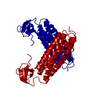 1rytS S: Starting model for refinement |
|---|---|
| Similar structure data |
- Links
Links
- Assembly
Assembly
| Deposited unit | 
| ||||||||
|---|---|---|---|---|---|---|---|---|---|
| 1 |
| ||||||||
| 2 | 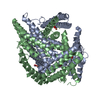
| ||||||||
| Unit cell |
| ||||||||
| Details | The biological assembly is the dimer in the asymmetric unit. |
- Components
Components
| #1: Protein | Mass: 16098.076 Da / Num. of mol.: 2 / Source method: isolated from a natural source / Source: (natural)   Sulfolobus tokodaii (archaea) / Strain: 7 / References: UniProt: Q96XZ7, UniProt: F9VPE5*PLUS Sulfolobus tokodaii (archaea) / Strain: 7 / References: UniProt: Q96XZ7, UniProt: F9VPE5*PLUS#2: Chemical | #3: Chemical | #4: Chemical | #5: Water | ChemComp-HOH / | |
|---|
-Experimental details
-Experiment
| Experiment | Method:  X-RAY DIFFRACTION / Number of used crystals: 1 X-RAY DIFFRACTION / Number of used crystals: 1 |
|---|
- Sample preparation
Sample preparation
| Crystal | Density Matthews: 2.08 Å3/Da / Density % sol: 40.41 % | ||||||||||||||||||||||||||||||
|---|---|---|---|---|---|---|---|---|---|---|---|---|---|---|---|---|---|---|---|---|---|---|---|---|---|---|---|---|---|---|---|
| Crystal grow | Temperature: 298 K / Method: vapor diffusion, hanging drop / pH: 8 Details: ammonium sulfate, HEPES-NaOH, pH 8.0, VAPOR DIFFUSION, HANGING DROP, temperature 298.0K | ||||||||||||||||||||||||||||||
| Crystal grow | *PLUS Method: vapor diffusion, hanging drop | ||||||||||||||||||||||||||||||
| Components of the solutions | *PLUS
|
-Data collection
| Diffraction | Mean temperature: 100 K |
|---|---|
| Diffraction source | Source:  SYNCHROTRON / Site: SYNCHROTRON / Site:  Photon Factory Photon Factory  / Beamline: BL-6A / Wavelength: 1 Å / Beamline: BL-6A / Wavelength: 1 Å |
| Detector | Type: ADSC QUANTUM 4 / Detector: CCD / Date: May 23, 2000 / Details: mirrors |
| Radiation | Monochromator: Si(111) / Protocol: SINGLE WAVELENGTH / Monochromatic (M) / Laue (L): M / Scattering type: x-ray |
| Radiation wavelength | Wavelength: 1 Å / Relative weight: 1 |
| Reflection | Resolution: 1.7→24.25 Å / Num. all: 32087 / Num. obs: 32087 / % possible obs: 99.8 % / Observed criterion σ(F): 0 / Observed criterion σ(I): 0 / Redundancy: 5.4 % / Biso Wilson estimate: 19.7 Å2 / Rmerge(I) obs: 0.054 / Net I/σ(I): 10.1 |
| Reflection shell | Resolution: 1.7→1.79 Å / Redundancy: 5.2 % / Rmerge(I) obs: 0.346 / Mean I/σ(I) obs: 2.2 / Num. unique all: 4410 / % possible all: 99.3 |
| Reflection | *PLUS Num. measured all: 171729 |
| Reflection shell | *PLUS % possible obs: 99.3 % |
- Processing
Processing
| Software |
| ||||||||||||||||||||||||||||||||||||
|---|---|---|---|---|---|---|---|---|---|---|---|---|---|---|---|---|---|---|---|---|---|---|---|---|---|---|---|---|---|---|---|---|---|---|---|---|---|
| Refinement | Method to determine structure:  MOLECULAR REPLACEMENT MOLECULAR REPLACEMENTStarting model: PDB ENTRY 1RYT Resolution: 1.7→24.29 Å / Rfactor Rfree error: 0.006 / Data cutoff high absF: 1564993.67 / Data cutoff low absF: 0 / Isotropic thermal model: RESTRAINED / Cross valid method: THROUGHOUT / σ(F): 0 / Stereochemistry target values: Engh & Huber Details: the oxygen molecules are putative. We still don't have any spectroscopic evidence to confirm that the molecule is "dioxygen".
| ||||||||||||||||||||||||||||||||||||
| Solvent computation | Solvent model: FLAT MODEL / Bsol: 48.4439 Å2 / ksol: 0.407613 e/Å3 | ||||||||||||||||||||||||||||||||||||
| Displacement parameters | Biso mean: 19.6 Å2
| ||||||||||||||||||||||||||||||||||||
| Refine analyze |
| ||||||||||||||||||||||||||||||||||||
| Refinement step | Cycle: LAST / Resolution: 1.7→24.29 Å
| ||||||||||||||||||||||||||||||||||||
| Refine LS restraints |
| ||||||||||||||||||||||||||||||||||||
| LS refinement shell | Resolution: 1.7→1.81 Å / Rfactor Rfree error: 0.015 / Total num. of bins used: 6
| ||||||||||||||||||||||||||||||||||||
| Xplor file |
| ||||||||||||||||||||||||||||||||||||
| Refinement | *PLUS % reflection Rfree: 5 % | ||||||||||||||||||||||||||||||||||||
| Solvent computation | *PLUS | ||||||||||||||||||||||||||||||||||||
| Displacement parameters | *PLUS | ||||||||||||||||||||||||||||||||||||
| Refine LS restraints | *PLUS
|
 Movie
Movie Controller
Controller






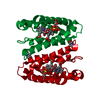
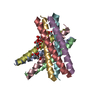

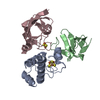
 PDBj
PDBj
